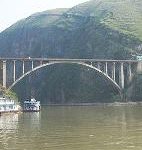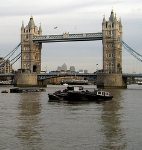China’s rapid economic growth has brought not only a rise in living standards, but also serious environmental pollution, which has continued despite greater central government funding for environmental protection and the promotion of the State Environmental Protection Administration (SEPA) to the Ministry of Environmental Protection (MEP). It is estimated that more than 80% of China’s coastal water and about 70% of its rivers and lakes are polluted with industrial waste, raw sewage and agricultural run-off. The core reasons for this are institutional, relating to the incentive structure for local government officials and the limited powers and independence of the MEP.
However in 2004, a group of 11 provinces and administrative regions along the Pearl River Basin, in southern China, joined together in a unique, bottom-up initiative. Members of the Pan-Pearl River Delta (PPRD) declared their willingness to cooperate in water pollution abatement and sustainable development. This suggested a new path for environmental resource management in China. But five years on, did this approach really represent a new horizon for managing transboundary rivers in China? Or did institutional issues still constrain the project?
The Pearl River Basin covers one-fifth of China’s area, contains one-third of its population and produces 40% of its GDP. The PPRD comprises the provinces and administrative regions of Guangdong, Guangxi, Yunnan, Sichuan, Guizhou, Hunan, Jiangxi, Fujian, Hainan, Hong Kong and Macao. Since 2004, these provinces and regions have taken part in mutual investment, industrial transfer, labour mobility projects and trade promotion, activities that have successfully promoted economic growth in the region (see Figure 1).
Although not severely polluted when compared with some of the other river basins in China, pollution in the Pearl River will grow with further industrial transfer and investment, which is directed towards the poorer, upstream provinces of the Pearl River (Guizhou, Guangxi, Yunnan and Jiangxi).
Guangdong province is the main victim of this pollution: in 2004, around half of the pollution in the river originated from outside Guangdong province, which is not only downstream, but is also obliged by prior agreement to transfer clean water to Hong Kong and Macao. Therefore, Guangdong initiated the PPRD. There have been some impressive results in terms of joint environmental education and awareness-raising projects, but there has still not been any successful environmental cooperation in terms of joint, active steps to reduce or abate water pollution along the river. To understand the complexity of this situation, we must consider the institutional structure in which local governments and environmental protection bureaus (EPBs) operate.
China’s government has a multi-levelled structure, with the central government in Beijing as the highest level in the chain of command. Every office has an assigned bureaucratic rank, which determines its decision-making and bargaining powers. Each government official is appointed and promoted by an official higher in the command structure and is thus accountable mainly to that person. Provincial governments hold the same bureaucratic rank as central ministries. Thus, they cannot force one another to act.
Central government evaluates and promotes local government officials according to their ability to show a high level of economic growth in the area under their jurisdiction. Thus, local government officials are often unwilling to invest in environmental protection projects, which may conflict with advancing growth. (Either in terms of shutting down polluting enterprises, or diverting resources towards sustaining the environment). China’s upward-accountability governance system also means that public pressure from below rarely forces local government officials to protect the environment or safeguard public health.
The process of decentralisation that accompanied economic reform over the past three decades has reduced the central government’s ability to enforce the implementation of its policies at the local level. Policies aimed at environmental protection are especially prone to poor implementation, as local officials focus on economic growth. One indication of this problem is that compliance with central government requirements on treatment of domestic waste-water is less than 20% in most of China’s cities.
The MEP is responsible for the protection of the natural environment in China, but it is weak, with limited funding and staff. Most importantly, the local branches of the MEP, the EPBs, depend on local governments for funding. Therefore, when local governments are not willing to invest in environmental protection, the work of the EPBs can be severely constrained.
Moreover, China’s process of decentralisation has created fierce competition between localities for resources, investment and market shares of products. Hence, they have great difficulty in managing shared resources. The central government has not been able to compel localities to act jointly. Although 86% of the Chinese population reside by and depend on transboundary rivers, such as the Pearl River, there is little sustainable management of these water resources.
Looking at China’s institutional structure, it is clear that there are many factors that reduce local government incentives to invest in environmental protection. However, the PPRD is an organisation of localities that aims to act together to control water pollution. How can this be explained?
Existing economic interdependencies between the provinces and their platform of cooperation – the PPRD economic development agreement – have allowed the promotion of cooperation in environmental protection in the region. But why has this cooperation not yielded active joint action to fight water pollution? I suggest that the main reasons for this limited cooperation are: the dependence of the EPBs on funding from local governments; the unwillingness of local governments of poorer upstream provinces to invest in joint efforts to reduce pollution; the inability of Guangdong province to oblige upstream provinces to act, because of the hierarchical rank structure of the respective governments; the unwillingness of Guangdong, though a rich province, to bear the burden of the costs of regional cooperation; and the efforts of Guangdong, as well as other provinces, to shift the responsibility for funding on to the central government.
Thus, the existing governance structure in China limits even this bottom-up initiative for environmental cooperation. It is also unlikely that this structure will be significantly reformed in the near future, since the central government continues to focus on strengthening its central power. However, under the existing structure there are some steps which could be taken to promote environmental cooperation and improve sustainable management of environmental resources in China.
First, environmental protection efforts should be included in the evaluation of local government officials, to enhance their incentives to invest in environmental protection programmes. Second, the independence of the MEP and EPBs should be strengthened through direct funding of their operations, in order to help them act independently of local governments and enhance their enforcement of regulations on environmental protection across China. Finally, the central government could improve the incentives of provinces and localities to participate in cooperative mechanisms, such as the PPRD. The central government could provide support both in clear administrative recognition of such mechanisms – and in financial assistance when it is needed.
Reut Barak ([email protected]) is a PhD candidate at the School of Oriental and African Studies (SOAS), University of London.
Homepage image by Just A Slice



